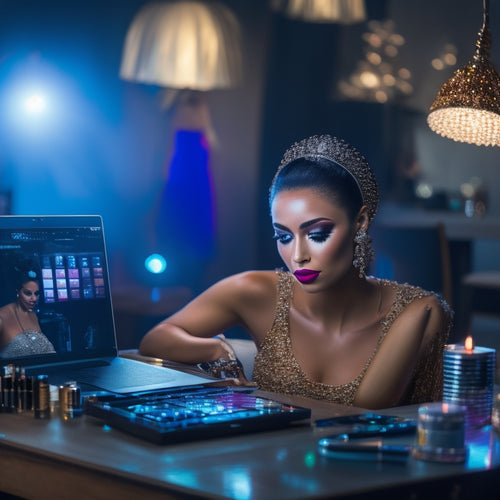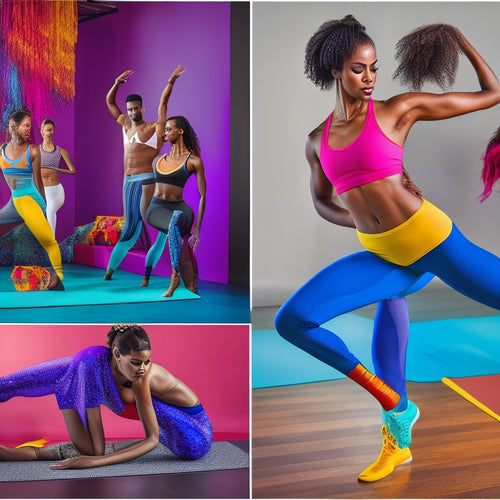
Innovative Dance Experiment Explores Video Learning
Share
The innovative dance experiment harnesses video learning to redefine traditional dance instruction, leveraging digital spaces to enhance teaching, learning, and creative expression. The experiment integrates video-based instruction, utilizing instructional videos for teaching choreography and facilitating distant collaboration. Video's significance in dance education lies in its ability to provide visual demonstrations, allowing students to rewind, pause, and replay instructional videos, thereby enhancing engagement and mastering complex choreography. While distance learning poses challenges, innovative teaching strategies and technology integration can overcome obstacles. As we explore the intersection of dance and technology, new possibilities emerge, and the future of dance education unfolds.
Key Takeaways
• The experiment integrates video-based instruction to facilitate dance learning, allowing for remote collaboration and creative expression.
• Video enables visual demonstration of choreography, allowing students to observe and mimic movements at their own pace.
• The use of video recording facilitates self-assessment, enabling students to review and refine their performances.
• The experiment overcomes distance learning challenges by leveraging video technology to provide remote instruction and feedback.
• Video-based instruction enhances engagement and mastery of complex choreography, promoting autonomy and self-motivation in students.
Dance Learning in Digital Spaces
In the context of dance education, the shift towards digital spaces has necessitated a reevaluation of traditional teaching methods, prompting a closer examination of the role of video in facilitating dance learning and transmission.
As dance educators adapt to virtual environments, the importance of virtual collaboration and creative expression expands. Video becomes an essential tool in facilitating this shift, enabling students to engage with dance instruction remotely.
Through video, students can access choreographic structures, instructional guidance, and creative tools, fostering a sense of community and shared learning experiences. By leveraging video's capabilities, dance educators can reimagine traditional pedagogies, promoting innovative and inclusive approaches to dance education in digital spaces.
The Experiment's Methodology
By examining the methodology employed in the dance experiment, it becomes clear that the integration of video-based instruction enabled students to develop their choreographic skills and creative expression in a remote learning environment. The experimental approach incorporated instructional videos to teach Rosas danst Rosas choreography, allowing students to create their own choreographic structures and dance videos. This methodology facilitated distant collaboration and enabled students to learn through copying dance via video.
| Instructional Techniques | Video-Based Learning | Student Outcomes |
|---|---|---|
| Choreographic skills | Video modeling | Developed creative expression |
| Dance technique | Video instruction | Improved choreographic structures |
| Creative tools | Video feedback | Enhanced dance performance |
| Collaborative learning | Video conferencing | Fostering distant collaboration |
The experimental design allowed for an in-depth analysis of the effectiveness of video-based instruction in dance education, providing valuable insights into the role of video in teaching dance in higher education programs.
Video as a Learning Tool
Employing video as a learning tool in dance education has significant implications for the way students absorb and process information, particularly in distance learning contexts where traditional in-person instruction is not feasible.
Video enables visual demonstration, allowing students to observe and mimic dance movements with precision. This enhances engagement, as students can rewind, pause, and replay instructional videos to master complex choreography.
Additionally, video facilitates self-assessment, enabling students to record themselves and compare their performance with the instructor's demonstration.
Challenges in Distance Learning
The shift to distance learning in dance education has introduced a unique set of challenges. These challenges include the lack of immediate feedback, limited opportunities for real-time corrections, and the need for students to develop a high level of autonomy and self-motivation.
One of the primary obstacles is fostering online engagement. Instructors must find innovative ways to encourage student participation and interaction in virtual classrooms. Remote interaction can be particularly difficult in dance education, where physical presence and immediate feedback are essential.
To overcome these challenges, educators must adapt their teaching strategies to accommodate the limitations of distance learning. They need to leverage technology to facilitate online engagement and promote self-directed learning.
Frequently Asked Questions
How Does the Instructor Ensure Student Engagement in Distance Learning?
Did you know that 75% of students report feeling more engaged in online courses with interactive elements? To promote student engagement in distance learning, instructors can utilize virtual icebreakers and interactive simulations, fostering a sense of community and encouraging active participation.
Can Dance Students With Disabilities Benefit From Video-Based Learning?
Dance students with disabilities can greatly benefit from video-based learning, leveraging accessibility tools to enhance inclusivity, and incorporating inclusive curriculum that caters to diverse needs, fostering a more equitable learning environment.
Are There Any Copyright Issues With Sharing Dance Instructional Videos?
As virtual dance studios proliferate, copyright concerns arise, prompting questions about fair use and Creative Commons licensing for instructional videos, necessitating thoughtful consideration to prevent infringement and guarantee accessibility for all students.
How Does the Instructor Provide Individualized Feedback in a Virtual Setting?
In a virtual setting, instructors can provide individualized feedback through real-time assessment, leveraging virtual coaching tools, such as video conferencing, screen recording, and instant messaging, to offer personalized corrections and guidance.
Can Video Learning Replace Traditional In-Person Dance Instruction Entirely?
While video learning offers flexibility and accessibility, it may not entirely replace traditional in-person dance instruction, as technical limitations, diverse learning outcomes, and the importance of personal connections, cultural nuances, and artistic expression may be compromised in a virtual setting.
Related Posts
-

Why Makeup Artists Need Innovative Design Tools
You're pushing the boundaries of makeup artistry, and traditional tools are holding you back. Innovative design tools...
-

5 Essential Tips for Online Dance Makeup Success
You're about to discover the secrets to a thriving online dance makeup presence. First, establish a strong online fou...
-

What Contemporary Dancewear Essentials Do Dancers Need
As a contemporary dancer, you need essentials that enhance your flexibility and creativity. Opt for high-waisted legg...


